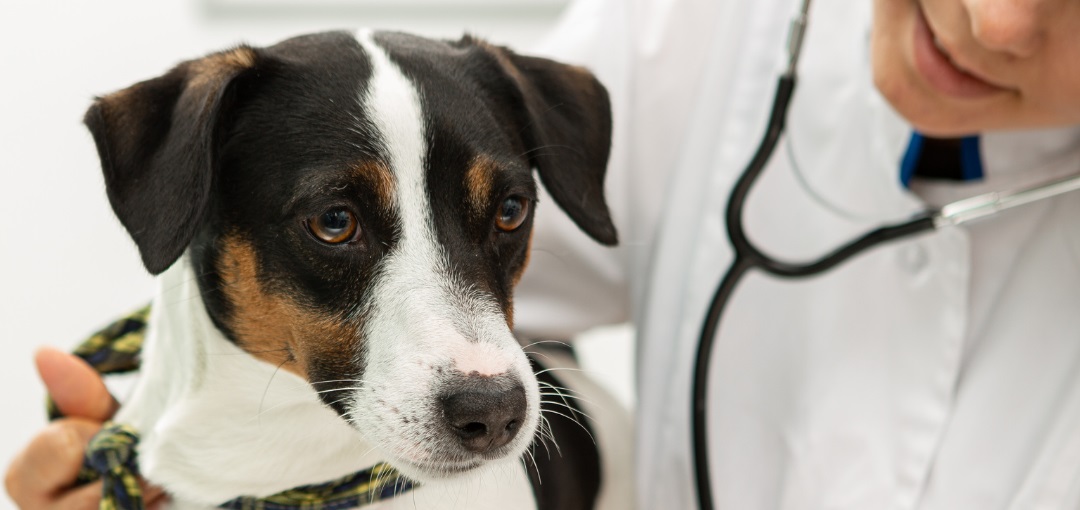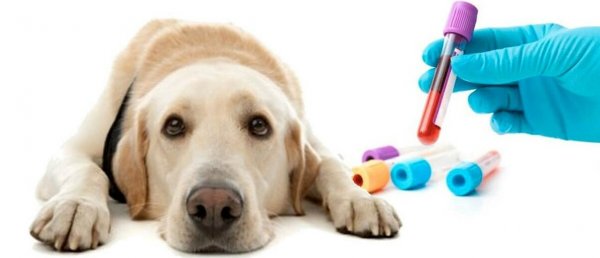The thyroid is an important organ that supplies the dog with the hormones T4 and T3. These hormones are essential for healthy metabolism in the dog’s body. If the production of these hormones is too low, the dog is said to have an underactive thyroid. You can read here what hypothyroidism means for your dog, how you can recognize this disorder, and what you can do about it.
The function of the thyroid in dogs

The thyroid gland (lat. Thyroidea) in dogs is located at the front of the neck, just like in humans. It consists of two main lobes, which are located on the right and left below the larynx and are connected by a tissue bridge (lat. isthmus) in front of the trachea. Controlled by the brain, the gland forms two different hormones that are very important for the metabolism in the dog’s body. It is the thyroid hormone thyroxine, or T4 for short, and the hormone triiodothyronine, or T3 for short. They are largely responsible for how the body deals with the nutrients it eats. Both hormones, T4 and T3, require iodine to form. If an iodine deficiency occurs, this causes hypothyroidism in the dog.
The organ is something like the control center in the dog’s body. It already has an enormous influence on the fetal development of the dog baby in the dog embryo in the womb. But also the functions:
- of the nervous system
- of the circuit
- the body temperature and
- various other bodily functions
are significantly influenced by thyroid function.
Definition – What is hypothyroidism in dogs?
The thyroid gland is located in the upper neck area of the dog and its two lobes lie tightly against the trachea on both sides. In a healthy state, the organ produces the important iodine-containing hormones thyroxine (T4) and triiodothyronine (T3) as well as calcitonin in sufficient quantities. While T4 and T3 play a crucial role in almost all metabolic processes in the body, calcitonin is particularly important for calcium balance. The function of the thyroid gland is controlled by the pituitary gland (= hypothalamus), which in turn releases its own regulatory hormones (TSH) and thus stimulates or throttles the activity of the thyroid gland in order to keep the hormone level in the blood as constant as possible.
However, if the function of the thyroid gland is disturbed, the hormone level in the dog’s blood changes, which can lead to different symptoms of the disease. If too many thyroid hormones are released, for example, due to a tumorous change in the glandular tissue, this is referred to as hyperfunction or hyperthyroidism. If the gland produces too few hormones, there is an under-function or hypothyroidism. Both conditions are pathological and must be regulated with appropriate medication.
What is hypothyroidism in dogs?
In this disease, the thyroid does not produce enough hormones, which are very important for the dog’s overall metabolism.
Causes – how does hypothyroidism occur in dogs?

Various causes can be responsible for an underactive thyroid gland and the resulting hormone deficiency. In some dogs, the glandular cells are destroyed as they get older, leading to a reduction in the size of the thyroid gland. Since an exact cause for this process has not yet been found, one speaks of idiopathic atrophy of the thyroid gland.
Inflammatory processes can also be the cause of the destruction of the glandular tissue, in which case one speaks of lymphocytic thyroiditis. Since the pituitary gland controls the thyroid function, pathological changes in this organ also have a negative effect on hormone production. Last but not least, the gland needs an adequate supply of iodine for the sufficient production of T4 and T3, so that an iodine deficiency can also lead to reduced production.
A special form of hypothyroidism already affects newborn puppies, this is a congenital defect. The affected puppies are usually significantly smaller than their siblings, lag behind in development and are often unable to survive.
Symptoms and signs of hypothyroidism in dogs
If the thyroid gland (lat. thyroidea) is underactive (lat. hypo), the veterinarian speaks of hypothyroidism. Unfortunately, the symptoms of hypothyroidism in dogs are not immediately noticeable. Rather, they are insidious and, at the beginning of an underactive thyroid, rather inconspicuous indications. But signs can be:
- fatigue and poor performance;
- Increased need for sleep and warmth;
- Weight gain with the same amount of food and exercise;
- diarrhea, constipation, or vomiting.
In addition to these rather unspecific signs, there are also more specific symptoms.
Specific symptoms of hypothyroidism in dogs
- Poor and slow coat growth, rarely changes in coat color
- Hair loss without itching
- thin, brittle, dry coat of affected dogs
- Hyperpigmentation on the skin, occasionally also on the claws
- increased dandruff formation
- skin infections
- inflammation of the ear canals
- Irregular cycle/reduced fertility in bitches
- Accumulation of water (oedema) in the head area
In addition to all these symptoms, an underactive thyroid also affects other organs in the dog’s body. The cholesterol level in the blood also rises and cardiovascular diseases can occur. Neurological abnormalities such as signs of paralysis can also occur. The thyroid hormones T4 and T3 are involved in the processes of carbohydrate, fat and protein metabolism. Their deficiency not only leads to poorer utilization of food, but also inhibits the production of red blood cells, which can lead to anemia.
What are the symptoms of hypothyroidism in dogs?
The symptoms of this disease are very complex and often not clearly assignable. If there is a suspicion of hypothyroidism, the veterinarian will, in addition to the clinical examination of the dog, primarily clarify laboratory values with a blood test.
Which dog breeds are particularly affected?
In principle, all dogs, regardless of breed, can be affected by hypothyroidism. However, the disease occurs more frequently in medium-sized and large dogs of middle age (about 5-8 years). Some breeds appear to be particularly susceptible. These include:
- Bobtail
- German Mastiff
- Doberman
- Golden retriever
- Hovawart
- Irish setter
- Giant Schnauzer
Diagnosis of hypothyroidism

In order to reliably determine the presence of hypothyroidism, the veterinarian must use a variety of examination methods. First, the visible and tangible external changes are determined by a clinical examination of the dog. Accurate reporting by the dog owner is also very important, since they are best able to assess changes in their dog’s behavior. A blood sample is then taken from the dog in order to obtain laboratory diagnostic findings. The most important parameters are:
- the cholesterol content
- the triglyceride content
- the presence of anemia
- the T4 content
- the TSH level
- the level of antithyroglobulin antibodies (ATA)
Since all of these values are influenced by different factors in the metabolism, it may be necessary to carry out further laboratory tests. For this purpose, the dog is first given thyroid hormones in order to then measure the changed blood values again. An ultrasound examination of the thyroid gland can also be helpful for the diagnosis.
Which medications help with hypothyroidism in dogs?
To treat an underactive thyroid gland, tablets containing the active ingredient L-thyroxine, which corresponds to the body’s own hormone T4 and compensates for the hormone deficiency in the dog’s body, are administered.
Treatment of hypothyroidism in dogs
Dogs that have been diagnosed with an underactive thyroid can be well treated with medication. The missing hormone T4 is given to the dog in the form of tablets. Almost all deficiency symptoms caused by the underactive thyroid can often be eradicated. However, it is important that the hormone tablets are administered in the correct dose every day. Correctly adjusted, the sick dog can recover completely. He will need the tablets for the rest of his dog’s life in order to get the important hormone for his body.
It is usually the case that the correct tablet setting takes time. But once the right dosage has been found, he can lead a completely normal life again. However, the controls in the animal practice will remain and level off at a half-yearly rhythm.
Homeopathic treatment has been proven to have no effect. Neither is an accompanying homeopathic therapy.
Hypothyroidism in dogs – costs
Unfortunately, the blood tests in the laboratory can cost several hundred euros, but they are essential for the diagnosis and subsequent therapy. Later, when the dog is properly adjusted to the medication, the costs for the hormone tablets and the six-monthly check-ups are reasonable. Likewise, the laboratory costs, since one now knows which values have to be checked.
Food for hypothyroidism
As a rule, no change in feed is necessary, but the topic should definitely be discussed with the treating veterinarian or a dog nutritionist. The diseased thyroid gland can possibly also be supported with feed supplements. Additives such as seaweed flour contain a lot of iodine and iodine deficiency is the most frequently diagnosed cause of hypothyroidism. The remaining capacity of the damaged thyroid can be maintained or at least supported.
This is how your dog feels after the treatment – the healing process
The various symptoms of hypothyroidism resolve at different speeds with successful therapy. Above all, the general condition of the dog usually improves within the first two to three weeks of treatment, while skin and coat changes or weight reduction take a little longer. After about three to four months from the start of therapy, all signs of the disease should be gone. The dog now needs the medication for life.
Which food is recommended for dogs with hypothyroidism?
A high-quality dog food, the main components of which are meat and animal products, supplemented with vegetables, fruit and fiber, is the best nutritional basis for a healthy dog. The hypofunction of the thyroid gland cannot be influenced, healed or avoided through food alone.
Prophylaxis and prevention – you can do that

The most common cause of hypothyroidism is iodine deficiency. Without an iodine supply, the thyroid hormones T4 and T3 cannot be formed sufficiently. Iodine is not produced by the body, but can be administered using feed supplements such as seaweed meal. Or put sea fish such as salmon, cod and haddock on the dog’s menu once a week. In contrast to river or pond fish, fish from the sea has a higher iodine content.
Hypothyroidism occurs in dogs worldwide and affects males and females alike. However, medium and larger dogs show a statistically higher tendency to develop hypothyroidism. From the age of six, a dog should have a routine annual health check anyway. This also includes a geriatric profile that gives conclusions about the organs.





























